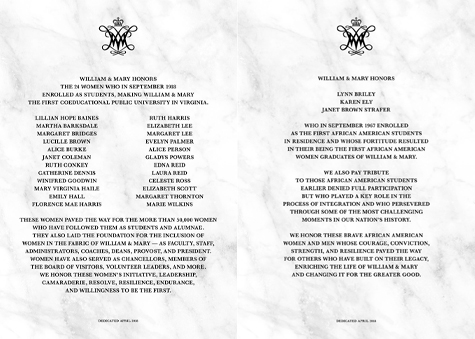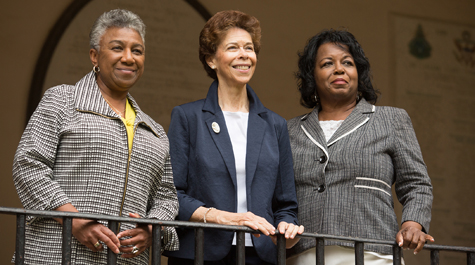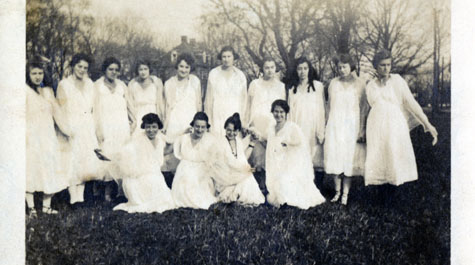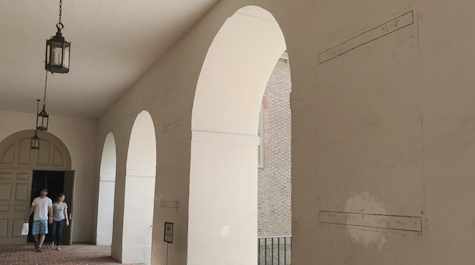New Wren plaques to honor African-American, women students
The Wren Building will soon bear two new plaques honoring William & Mary’s first women and African-American residential students. The plaques will be unveiled during a public ceremony at noon on April 19. Attendees are asked to register in advance.
One of the tablets will include the names of W&M’s first three African-American residential students who are being honored throughout the 2017-18 academic year with special events and programs as part of a 50th anniversary commemoration of their arrival on campus. The other plaque will include the names of the first 24 women to enroll at W&M as students in 1918. Starting next fall, the university will mark the 100th anniversary of that occasion with a yearlong celebration.
“To have plaques honoring the first residential African-American students and the first women in such a historical building on campus is a significant gesture toward the inclusion part of diversity and inclusion and hopefully will continue in other tangible ways,” said Jacqui McLendon, emerita professor of English and chair of the 50th commemoration committee.
 That committee along with the one organizing the 100th anniversary celebration sponsored the plaques. Jayne Barnard, co-chair of the 100th commemoration committee and a member of the 50th, said that both groups sought to create physical objects on campus to honor women and African-Americans.
That committee along with the one organizing the 100th anniversary celebration sponsored the plaques. Jayne Barnard, co-chair of the 100th commemoration committee and a member of the 50th, said that both groups sought to create physical objects on campus to honor women and African-Americans.
W&M President Taylor Reveley recognized the importance of honoring those groups in a permanent way in the most historic building on campus, Barnard said.
“This never would have happened without his support,” Barnard said, noting the significance of this being one of his last acts as president of the university. He will retire on June 30, 2018.
Reveley will be among the speakers at the plaque unveiling, along with McLendon; Val Cushman, director of alumnae initiatives and co-chair of the 100th committee; and Susan Kern, executive director of the historic campus.
 Kern has been working with the committees on the content of the plaques as well as their fabrication and installation.
Kern has been working with the committees on the content of the plaques as well as their fabrication and installation.
“The committees have worked long and hard on tweaking the language for these plaques and getting something that sounds for the ages but also of the moment,” she said.
The groups worked with University Communications’ Web & Design office to design the tablets, which will bear W&M’s cypher along with text honoring both the university’s first women students and first African-American residential students: Lynn Briley ’71, Karen Ely ’71 and Janet Brown Strafer ’71, M.Ed. ’77, known as the “Legacy 3.”
The tablet for the 50th anniversary also pays tribute to “those African-American students earlier denied full participation but who played a key role in the process of integration and who persevered through some of the most challenging moments in our nation’s history.” The 100th anniversary tablet notes that the 24 students “paved the way for the more than 50,000 women who have followed them as students and alumnae. They also laid the foundation for the inclusion of women in the fabric of William & Mary.”

Like the other plaques on the piazza, the new plaques will be marble. The older plaques vary slightly in size, but the new plaques will be 42 inches wide, 60 inches tall and 3 centimeters thick. They will be mounted on the piers framing the west steps and facing the building.
Some people have asked Kern why the new tablets are outside instead of inside the building, but she sees the location as appropriate.
“The tablets that are inside are war memorials, so they’re marking people who are remembered because they died whereas out on the piazza we have tablets about William & Mary’s priorities and role in creating the U.S., so it’s really about people who are being remembered for what they did while they lived,” she said.
Following the unveiling ceremony, which will begin with the tolling of the Wren bell, a reception will be held in the Wren courtyard.
“When these two plaques are installed, the Wren Building at last will contain the names of women and people of color, and those names will remain there forever,” said Barnard.















